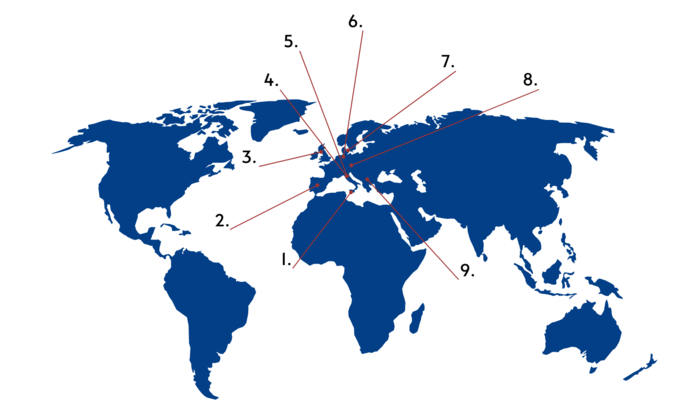Subject Area and Research Team: I. Studies on metabolic, therapy and toxicity with mass spectrometry, electron paramagnetic resonance and NMR analysis
Research topics
1. Search for new indicators of environmental pollution affecting human health and their determination in bodily fluids (e.g. pesticides, plasticizers, PAH’s, PFAS etc.
2. Estimating the health risks resulting from exposure to pollutants.
3. Assessment of changes in the microbiome of various ecological niches in contact with pollutants and determination of their impact on human health and environmental safety.
4. Differential diagnosis of accidental, suicidal and criminal intoxication related to drug intoxication, classical drugs and new psychoactive substances and ethyl alcohol poisoning.
5. Driving under influence (DUI) of drugs and ethyl alcohol.
6. Evaluation of in vitro metabolic stability of novel drug candidates. Development of Quantitative Structure-Metabolic Stability Relationships models using machine learning methods.
7. Analysis of VMA/HVA ratio in urine samples for diagnostic purpose in neuroblastoma, pheochromocytoma and CNS disorders.
8. The lipid disturbances in metabolic and neurodegenerative diseases.
9. The alterations of lipid metabolism in various malignancies.
10. Cardiovascular diseases – markers for diagnosis and therapy drug monitoring.
Coordinators
| Coordinator #1 | Coordinator #2 | |
|---|---|---|
| Name and surname |  |
 |
| Academic degree | Prof. Dr. Habil. | Prof. Dr. Habil. |
| Employment unit | Department of Environmental Toxicology | Department of Biochemistry |
| Polish Platform of Medical Research | Prof. Dr. Habil. Lidia Wolska | Prof. Dr. Habil. Ewa Słomińska |
| lidia.wolska@gumed.edu.pl | ewa.slominska@gumed.edu.pl | |
| Phone number | +48 58 523 19 39 | +48 58 349 14 62 |
Research Team: I. Studies on metabolic, therapy and toxicity with mass spectrometry, electron paramagnetic resonance and NMR analysis
Team Members I. Studies on metabolic, therapy and toxicity with mass spectrometry, electron paramagnetic resonance and NMR analysis (193 KB)Feel free to contact one of our coordinators to join our Research Team.
Key current projects
1. Intensive rearing of poultry – identification of changes occurring in the environment and their impact on human health.
2. Investigation of human skin barrier to selected endocrine disrupting chemicals (EDCs) in the presence of surfactants.
3. Estimation of usefulness of determination of biomarkers (fatty acid ethyl esters – FAEE, ethyl glucoronate – EtG, ethyl sulphate – EtS) indicating alcohol consumption by pregnant women in neonatal meconium to diagnose prenatal exposure to alcohol.
4. Estimating the time of death on the basis of a multi-parameter analysis of biological and physicochemical processes (mainly on the basis of determining the concentration of potassium ions in the vitreous body of the eye) for the purposes of forensic medicine.
5. Co-operation with Medical University of Warsaw (Department of Drug Technology and Pharmaceutical Biotechnology) for estimation of metabolic stability of novel arylpiperazine derivatives as anti-depressive drug candidates.
6. Metabolism of very long chain fatty acids and pathophysiological role of fatty acid elongase 1.
7. Alterations of fatty acid profiles in various cancers – evaluation of their role and diagnostic significance.
8. CardioCarePack – a package of modern drug-monitored therapy solutions in patients with cardiac arrhythmias in development of personalized medicine.
9. The role of nitric oxide dependent pathways in the procognitive action of positive allosteric modulators of muscarinic and metabotropic glutamate receptors.
Key grants
| Funding agency/grant number | Title of the project | Years | |
|---|---|---|---|
| 1. | NCN (Poland), the competition SONATA 10, No. project UMO-2015/19/D/NZ7/03283 | Comparative assessment of the fruit and vegetable peel barrier degree for currently used pesticides – estimation of exposure to consumption | 2016-2019 |
| 2. | NCN (Poland), the competition PRELUDIUM 1, No. project: UMO- 2011/01/N/NZ7/01547 | New tools in the methodology of health risk assessment in the conditions of environmental exposure to chemical emissions | 2011-2014 |
| 3. | NCN, OPUS 10, 04-0181/09/265 | Estimation of usefulness of determination of biomarkers indicating alcohol consumption by pregnant women in neonatal meconium to diagnose prenatal exposure to alcohol | 2016-2021 |
| 4. | NCN | Modeling of quantitative structure-metabolic stability relationships as a tool to improve design of potential novel antidepressant and anxiolytic drug candidates | 2016-2021 |
| 5. | Visegrad Group (V4)-Korea Joint Research Program on Chemistry and Chemical Engineering, Seoul National Univeristy, Seoul, Academy of Sciences in Czech Republic, Brno, Academy of Sciences in Hungary, Debrecen, Academy of Sciences in Slovakia, Bratislava, Medical University of Gdańsk, Gdańsk, (as Polish co-ordinator of the project) | Microelectrophoretic tools for bioanalysis | 2018-2020 |
| 6. | NCN, SONATA BIS 6, 2016/22/E/NZ4/00665 | The alterations of lipid metabolism in colorectal cancer – their role in the development of disease and the asessment of antiproliferative action of lipid metabolism inhibitors | 2017-2021 |
| 7. | NCN. OPUS 19, 2020/37/B/NZ4/00821 | Metabolism of very long chain fatty acids and pathophysiological role of fatty acid elongase -1 (ELOVL1) | 2021-2024 | 8. | NCN. PRELUDIUM 19, 2020/37/N/NZ5/00726 | Alterations of fatty acid profiles of different lipid classes in breast cancer – evaluation of their role and diagnostic significance | 2021-2023 |
| 9. | NCBiR / POIR.01.01.01-00-1196/19 | CardioCarePack – a package of modern drug-monitored therapy solutions in patients with cardiac arrhythmias in development of personalized medicine | 2020-2023 |
| 10. | NCN, OPUS 17/ UMO-2019/33/B/NZ7/02699 | The role of nitric oxide dependent pathways in the procognitive action of positive allosteric modulators of muscarinic and metabotropic glutamate receptors | 2020-2023 |
International cooperation
| Foreign partner (unit name) | Principal investigator(s) | Area of cooperation | |
|---|---|---|---|
| 1. | Università degli Studi di Palermo | UNIPA · Department of experimental medicine and clinical neurosciences, Italy | Prof. Fabio Buccheri | Electron microscope tests |
| 2. | Obesity and Metabolism group, Biomedical Research Institute of Murcia (IMIB-Arrixaca), 30120 Murcia, Spain | Bruno Ramos-Molina, Ph.D. | Obesity and Metabolism Group |
| 3. | Department of Applied Science, School of Computing, Engineering and Built Environment, Glasgow Caledonian University, UK | Calum Morrison Ph.D., Maciej Tankiewicz Ph.D. Eng. | Multi-residue method for the determination of 16 recently used pesticides from various chemical groups in aqueous samples by using DI-SPME coupled with GC–MS, Talanta 107(2013) 1–10 Application and optimization of headspace solid-phase microextraction (HS-SPME) coupled with gas chromatography–flame-ionization detector (GC–FID) to determine products of the petroleum industry in aqueous samples, Microchemical Journal 108 (2013) 117–123 |
| 4. | Department of Agriculture, Food, Environment and Forestry (DAGRI), University of Florence, Sesto Fiorentino, Italy | Prof. Carlo Viti, Marta Potrykus, Ph.D. | The metabolic shift in highly and weakly virulent Dickeya solani strains is more affected by temperature than by mutations in genes encoding global virulence regulators. 2020, FEMS Microbiology Ecology, 1;96(3):fiaa023 |
| 5. | Department of Biology, University of Florence, Sesto Fiorentino, Italy | Prof. Alessio Mengoni, Marta Potrykus, Ph.D. | The metabolic shift in highly and weakly virulent Dickeya solani strains is more affected by temperature than by mutations in genes encoding global virulence regulators. 2020 FEMS Microbiology Ecology. 1;96(3):fiaa023 Comparison of Highly and Weakly Virulent Dickeya solani Strains, With a View on the Pangenome and Panregulon of This Species. 2018 Frontiers in Microbiology.;9:1940. doi:10.3389/fmicb.2018.01940 |
| 6. | Fraunhofer Institutfür Toxikologie und Experimentelle Medizin ITEM In-vitro und Mechanistische Toxikologie, Germany | Milena Chraniuk, Prof. Lidia Wolska | Ph.D. Student internship, implementation of Ph.D. thesis |
| 7. | Department of Nutrition, Exercise and Sports, University of Copenhagen | Prof. Faidon Magkos | Obesity Research |
| 8. | University of Chemistry and Technology, Department of Biochemistry and Microbiology, Czech Republic | Dr Habil. Magdalena Urbaniak, Maciej Tankiewicz, Ph.D. Eng. | The stimulating role of syringic acid, a plant secondary metabolite, in the microbial degradation of structurally-related herbicide, MCPA, PeerJ 24 (2019) art. 6745, 1-19 Removal and Ecotoxicity of 2,4-D and MCPA in Microbial Cultures Enriched with Structurally-Similar Plant Secondary Metabolites, Water 11 (2019) art. ID 1451, 1-16 |
| 9. | Department of Analytical Chemistry, Faculty of Chemistry, University of Sofia “St. Kl. Okhridski”, Bulgaria | Prof. Lidia Wolska, Prof. Vasil Simeonov, Prof. Stefan Tsakovski, Dr. Habil. Justyna Rogowska | Cooperation in research: Surface sediments pollution due to shipwreck s/s “Stuttgart”: a multidisciplinary approach, Stoch. Environ. Res. Risk Assess 29(7) (2015) 1797-1807 Novel approach to ecotoxicological risk assessment of sediments cores around the shipwreck by the use of self-organizing maps, Ecotoxicol. Environ. Saf. 104 (2014) 239-246 |

Key publications
1. Potrykus Marta, Redko Vladyslav, Głowacka Katarzyna, Piotrowicz-Cieślak Agnieszka, Szarlej, Paweł, Janik Helena, Wolska Lidia Polypropylene structure alterations after 5 years of natural degradation in a waste landfill. Science Of The Total Environment 2021: vol.758, 143649.
2. Rogowska Justyna, Olkowska Ewa, Ratajczyk Wojciech, Wolska Lidia Gadolinium as a new emerging contaminant of aquatic environments. Environ. Toxicol. Chem. 2018 : vol. 37, nr 6, s. 1523-1534
3. Joanna Jurewicz, Joanna Majewska, Andrzej Berg, Katarzyna Owczarek, Radosław Zajdel, Dorota Kaleta, Andrzej Wasik, Dominik Rachoń Serum bisphenol A analogues in women diagnosed with the polycysticovary syndromeeis there an association?. Environmental Pollution 2021, vol. 272, 1159622. https://doi.org/10.1016/j.envpol.2020.
4. Rogowska Justyna, Cieszyńska-Semenowicz Monika, Ratajczyk Wojciech, Wolska Lidia Micropollutants in treated wastewater. Ambio 2020 : vol. 49, nr 2, 487-503
5. Natalia Miękus, Piotr Kowalski, Ilona Olędzka, Alina Plenis, Ewa Bień, Aleksandra Miękus, Małgorzata Krawczyk, Elżbieta Adamkiewicz-Drożyńska, Tomasz Bączek, Figaj Donata, Czaplewska Paulina, Przepióra Tomasz, Ambroziak Patrycja, Potrykus Marta, Skorko-Glonek Joanna. Lon rotease is important for growth under stressful conditions and pathogenicity of the phytopathogen, bacterium Dickeya solani. Int. J. Mol. Sci. 2020 : vol. 21, nr 10, art. ID 3687, s. 1-30.
6. Szymon Ulenberg, Mariusz Belka, Paweł Georgiev, Grzegorz Ślifirski, Marek Król, Franciszek Herold, Tomasz Bączek The influence of phase II enzymes on in vitro half-life of pirydo[1,2-c]pirymidine derivatives as structural analogues of arylpiperazine. Microchemical Journal, 159 (2020)
7. Mika A, Halinski LP, Sledzinski T, Malgorzewicz S, Woloszyk P, Dardzinska J, Debien-Slizien A, Chmielewski M. Analysis of Serum Fatty Acids Profile in Kidney Transplant Recipients. Nutrients 2021, 13(3): 805
8. Cieślik Paulina, Domin Helena, Chocyk Agnieszka, Gruca Piotr, Litwa Ewa, PŁOSKA AGATA, RADULSKA ADRIANNA, PELIKANT-MAŁECKA IWONA, Brański Piotr, KALINOWSKI LESZEK, Wierońska Joanna M. Simultaneous activation of mGlu2 and muscarinic receptors reverses MK-801-induced cognitive decline in rodents. Neuropharmacology 2020 : vol. 174, art. 107866, s. 1-16.